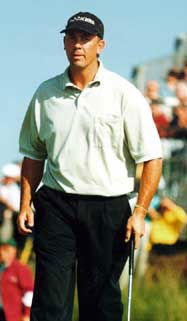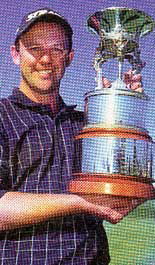Best tips from the stars
Lehman, Price, Owen and Co pass on their advice

 |
Occasionally I like to look back on old notes and tapes of interviews I have done in the past. It throws up all kinds of material that may not have been relevant or usable then but can certainly have an impact now.
I have been fortunate to speak with many top players and ask hundreds of questions. One, I recall which usually got a positive response was when I suggested they pass on a tip to amateurs who aspire to be just like them.
Just before Tom Lehman went out to win the 1996 Open at Royal Lytham, I was hanging around the practice ground. He and Nick Faldo were the last ones there and I was checking with his caddie Andy Martinez to see just what irons he was carrying in his bag.
Tom broke off from his practice session and we started chatting and while wishing him luck, I cheekily asked him what the best piece of advice he would give to amateur golfers.
"Find what you do well and perfect it," he told me. "My swing isn't like Payne Stewart's or Ernie Els. I don't have this picture perfect swing. My swing is a little bit home made. So just work on what you do well and work hard at perfecting it. Don't try to be so somebody you're not."
Lehman certainly has his own idiosyncrasies – in fact his swing always looks a little agricultural but it is repeating and through the late 1990s there were few who could match his consistency.
For the up-and-coming Greg Owen, the advice was simple: "If the top pros need lessons, then so do amateurs. Get proper coaching and do as much practice as you can. If club players want to improve, they need the right coaching."
He told me he was 14 years old before he broke 90.
"I went from 91 to 86, which was quite big for me because I just couldn't get pass 90. But I went out with a friend and he helped me out with a bit of course management that made a big difference. I was probably 15 when I broke 80 and broke 70 the following year."
Rodger Davis, the Australian now plying his trade on the US senior circuit, swears by routine.
"I tell amateur golfers to develop a good routine one and try not to change it. Because as soon as you change your routine, either the way you come into the ball or your time taken to hit a shot, all of a sudden the brain says, 'This is something different,' and gets scrambled.
"Then all of a sudden you start thinking about the out of bounds and the water hazards. A good routine actually takes pressure away rather than putting it on."
 |
Jamie Spence is a great believer in amateur golfers practising their short game
"I know guys when they've got some time to practise, they want to go and hit drivers, smash balls down the range. But the way you are going to get your handicap down is become better chippers and putters. Simple as that.
"We play pro-ams all the time and most of the guys' bunker play is so far behind the rest of their game. They don't know how to get out of bunkers. If they just had half-an-hour lesson with a pro, it would make such a difference."
For Zimbabwe’s Mark McNulty, one of the friendliest players on the circuit the advice is about playing within yourself.
"When amateurs play with me, they get up tight and try and play to the same level as the pro. Just remember that if you have a 15 handicap or a 10 handicap use it. 'Play within yourself; don't play the shot that Tiger Woods has just played, play the shot you are able to play."
 |
Welsh Ryder Cup hero Phillip Price is a phlegmatic character who speaks his mind.
"Most amateurs tend to select a club for their best-struck golf shot. But they hit those so infrequently they would be better off taking a club that would allow for their average shot."
Patrik Sjoland from Sweden, practises harder than most and is known for his long-irons and fairway woods but he says it’s important for amateurs to practice more around the greens.
"Concentrate on the short game. Most get to the edge of the green in two or three shots, then take another three or four to get the ball in the hole. Instead of rushing off after work to play nine holes, why not spend an hour around the green working on chipping, putting and pitching."
American Bob May agrees.
"Your average amateur could take a couple of shots off their game each round if they practised their putting more. Work on the chipping and putting instead of going on the range and beating balls all day. You just don't realise how many shots you are throwing away."

